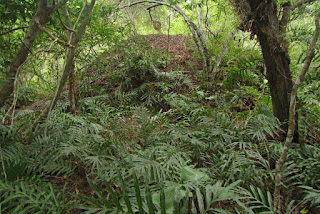Just after writing about how the mouth of Barr Creek can have violent episodes, I was able to actually able to film another creek having one. Deep Creek at Clifton Beach is about one quarter the size of Barr Creek and longshore often blocks its mouth with sand during the dry season. Last week the mouth of the creek was a mere trickle and then we had a little bit of rain.
The creek came up so fast that a little old lady who went for a walk along the beach could not get back. I had helped her wade back across by walking out into the sea and crossing where the force of the water was less.
Some people arrived and were quite worried that their big dogs would jump in and get washed away but dogs have skinny legs and seem to be able to walk through really fast water so they relaxed. Then everyone just started having fun. A man was trying to body surf the waves but his dog kept climbing on his back and riding him like a surf board which was really annoying. .
This time I could stand in right beside the channel and film the biggest of the waves just in front of me and I saw a lot of things that I had never seen before and you can see some of them in the video. The standing waves move slowly upstream. When they get really big, they collapse into rolling surge of slosh and which is washed downstream leaving the surface of fast flowing water almost flat. After a few seconds, a new set of standing waves formed and over twenty seconds grew to full size and then as before collapsed. I always thought that ocean swells moved through the flood and made the standing waves peak but this is not the case. The standing waves were in this case a self-generating cycle. In some of the standing waves, vortices are making patterns in the crests of the waves.
In my search for information about standing waves I discovered that if Barr Creek was in America, people would go nuts about it. The Waimea River on the Hawaiian Island of Oahu is their version of Barr Creek
Does Barr Creek really compare to the Waimea River? They are almost perfectly matched - look at this.
The difference is that Barr Creek has a maximum drop to the sea of about 3.5 m whereas the Waimea River drops down by 6-7 m as the beach is built up high by 10 m waves (their king tides are only 0.5 m!). Barr Creeks standing waves top out at about a 1.5 m high whereas the Waimea River standing waves seem to be twice as big at full power. Like the Waimea River, one has to wait until the mouth is blocked and the creek fills up with freshwater and when it is on the point of bursting out. Kids sometimes dig a channel on a very low tide and off it goes. Unfortunately this is not a common event. However Barr Creek has several tide powered events every year and where the water drops about a metre between the creek and the sea and there is still plenty of action. These events are bigger than my video of Deep Creek. The best time to play is when the creek is running fresh during the wet season and you do not have to worry about box jelly fish but you always have to look for crocodiles.
The creek came up so fast that a little old lady who went for a walk along the beach could not get back. I had helped her wade back across by walking out into the sea and crossing where the force of the water was less.
Some people arrived and were quite worried that their big dogs would jump in and get washed away but dogs have skinny legs and seem to be able to walk through really fast water so they relaxed. Then everyone just started having fun. A man was trying to body surf the waves but his dog kept climbing on his back and riding him like a surf board which was really annoying. .
This time I could stand in right beside the channel and film the biggest of the waves just in front of me and I saw a lot of things that I had never seen before and you can see some of them in the video. The standing waves move slowly upstream. When they get really big, they collapse into rolling surge of slosh and which is washed downstream leaving the surface of fast flowing water almost flat. After a few seconds, a new set of standing waves formed and over twenty seconds grew to full size and then as before collapsed. I always thought that ocean swells moved through the flood and made the standing waves peak but this is not the case. The standing waves were in this case a self-generating cycle. In some of the standing waves, vortices are making patterns in the crests of the waves.
In my search for information about standing waves I discovered that if Barr Creek was in America, people would go nuts about it. The Waimea River on the Hawaiian Island of Oahu is their version of Barr Creek
Does Barr Creek really compare to the Waimea River? They are almost perfectly matched - look at this.
 |
| Barr Creek with 500 m scale bar (images Google Earth) |
 |
| Waimea River in Oahu, Hawaii |



























